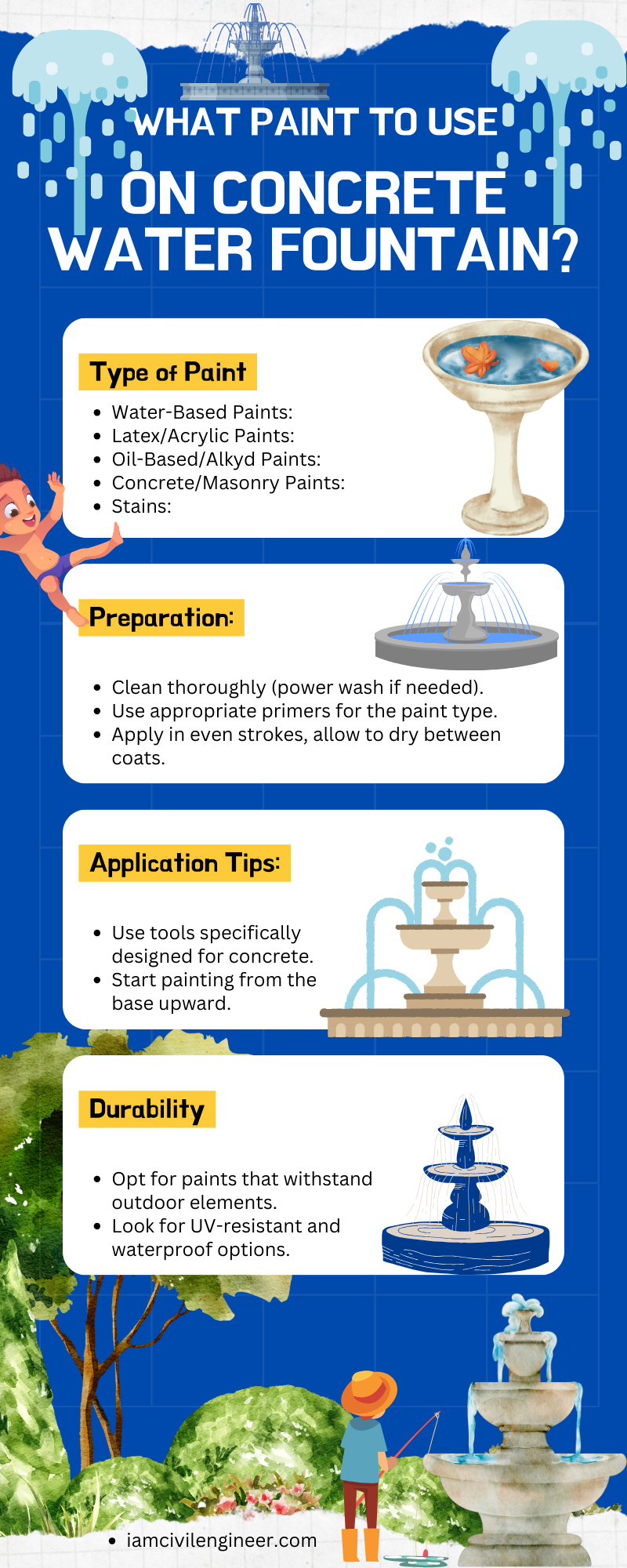Can I apply paint on concrete water fountains?
You can apply paint on concrete water fountains, but it is important to use the right type of paint. Water-based paints are the best choice for concrete fountains because they are less likely to peel or chip. However, oil-based paints can also be used if they are properly sealed. Be sure to follow the manufacturer’s instructions for the best results.
Can I use Latex/Acrylic Paint on concrete fountain?
If you want to add a personal touch to your concrete fountain, you may be wondering if you can paint it. The short answer is yes, you can paint concrete, and you can even use latex or acrylic paint. However, there are a few things you need to keep in mind in order to get the best results.
First of all, it’s important to clean the concrete thoroughly before painting. You don’t want any dirt or debris to interfere with the paint job. Once the concrete is clean, you can start painting.
If you’re using latex or acrylic paint, you’ll need to prime the concrete first. This will help the paint to adhere better and will also prevent it from chipping or flaking off over time. Once the primer is dry, you can start painting.
It’s important to use a paint that is designed for concrete. Regular paint won’t adhere well to the concrete and is more likely to chip and flake over time. There are a number of concrete-specific paints on the market, so be sure to choose one of these.
Once you’ve chosen your paint, you need to decide on a color. You can either go with a solid
Using Alkyd/Oil-Based Paint
There are a few reasons why you might choose to use an oil-based or alkyd paint over a water-based paint. Oil-based paint takes longer to dry, but it’s more durable and easier to clean up with mineral spirits. Alkyd paint is made with a synthetic resin that gives it a harder, more durable finish than oil-based paint. It also dries more quickly.
If you’re painting a piece of furniture or a door that will get a lot of wear and tear, an oil-based or alkyd paint is a good choice. It’s also a good choice for painting trim and molding, since it won’t require touch-ups as often as a water-based paint.
One downside of oil-based and alkyd paints is that they’re more likely to yellow over time. They also tend to be more expensive than water-based paints. When using an oil-based or alkyd paint, be sure to use a primer designed for use with that type of paint. You’ll also need to use mineral spirits for cleanup.
Like Us on Facebook!
Using Concrete or Masonry Paint on concrete fountains
Whether you have a pre-existing concrete fountain or are thinking about installing one, you may be wondering what type of paint to use. Concrete and masonry paint is a good option for concrete fountains. This type of paint is specifically designed to adhere to concrete and masonry surfaces, and it can provide a durable, long-lasting finish.
Subscribe Us on YouTube!
When selecting a concrete or masonry paint, be sure to choose one that is specifically designed for use on fountains. These paints typically contain a waterproofing agent that will help protect the fountain from water damage.
Before painting your fountain, be sure to clean the surface thoroughly. You may need to use a power washer to remove any dirt, grime, or algae that has built up on the surface. Once the surface is clean, allow it to dry completely.
Once the surface is dry, you can begin painting. Be sure to use a paintbrush or roller specifically designed for use on concrete. Start by painting the base of the fountain, working your way up. Apply the paint in even strokes, taking care to avoid drips or runs.
Allow the first coat of paint to dry completely before applying a second coat. Once the second coat is dry, your
Using Stain for Concrete for fountains
Whether you are staining old concrete or new concrete, the process is relatively simple. The key to success is in the prep work. Once the concrete is properly prepped, the actual staining is a breeze.
The first step is to clean the concrete. This can be done with a pressure washer or a garden hose with a high-pressure nozzle. If you are using a pressure washer, be careful not to damage the concrete.
Once the concrete is clean, you will need to etch it. This can be done with a Muriatic Acid solution. The ratio is 1 part acid to 10 parts water. You will need to apply the solution to the concrete with a pump sprayer and let it sit for 10-15 minutes.
Once the etching is complete, you will need to neutralize the acid. This can be done with a baking soda and water solution. The ratio is 1 part baking soda to 2 parts water. Apply the solution to the concrete with a pump sprayer and let it sit for 10-15 minutes.
After the concrete is neutralized, you will need to rinse it with clean water. Once the concrete is completely dry, you are ready to stain.

















